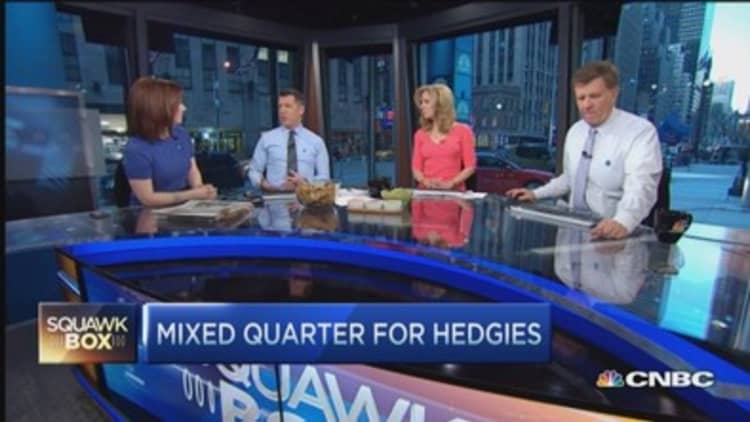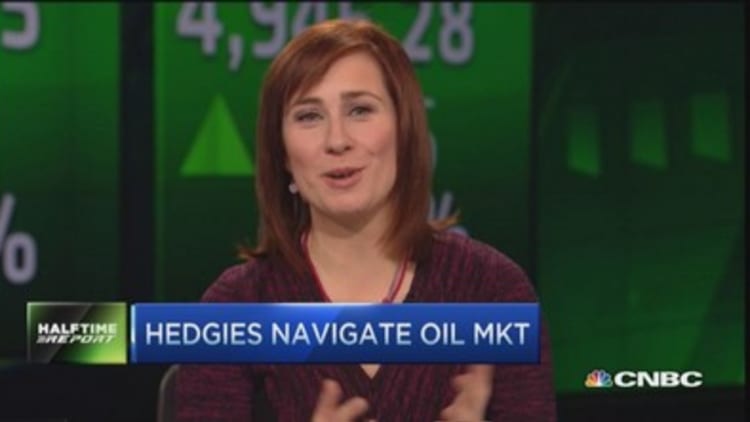The robots are winning again.
Hedge funds that rely on sophisticated computer algorithms to invest are once again producing the industry's best returns.
Funds managed by ISAM, Cantab, AHL, Systematica and others produced double-digit gains over the first three months of 2015, according to private performance figures obtained by CNBC.com.
Those funds practice a so-called trend-following strategy using contracts on the future price of securities related to stocks, bonds, currencies and commodities.
Many of them caught big macroeconomic trends in the first quarter, like bets on the U.S. dollar gaining in value versus the euro (it gained 11 percent) and other currencies; government bonds in the U.S. and Europe appreciating (e.g., 10-year U.S. Treasurys were up 2.6 percent); and also stocks rising in Europe and Japan (e.g., the Nikkei 225 rose 10 percent).
"Trend followers and other macro investors clearly outperformed," said Robert Christian, head of research at K2 Advisors and Franklin Templeton Solutions. "What's carried people is just classic, good old trend following."
Brand name hedge fund performance
| Fund | 2015 net return | Date | Leadership | Strategy | Click to edit |
|---|---|---|---|---|---|
| Tiger Ratan | 22.40% | 31-Mar | Nehal Chopra | Long/short equity | |
| ISAM Systematic Fund | 15.12% | 31-Mar | Stanley Fink | Managed futures | |
| Bridgewater Pure Alpha II | 14.50% | 31-Mar | Ray Dalio | Macro | |
| CCP Quantitative Programme (Cantab) | 13.69% | 31-Mar | Ewan Kirk | Managed futures | |
| Passport Global | 12.50% | 31-Mar | John Burbank | Long/short equity | |
| BlueTrend Fund (Systematica) | 11.65% | 31-Mar | Leda Braga | Managed futures | |
| AHL Diversified (Man) | 10.90% | 20-Mar | Matt Sargaison | Managed futures | |
| Point72 Asset Management (family office) | 7.50% | 31-Mar | Steve Cohen | Multistrategy | |
| Eton Park Fund | 7.10% | 31-Mar | Eric Mindich | Multistrategy | |
| Kensington/Wellington (Citadel) | 6.85% | 31-Mar | Ken Griffin | Multistrategy | |
| Paulson International | 6.60% | 20-Mar | John Paulson | Merger arbitrage | |
| Graham Absolute Return Trading | 6.50% | 31-Mar | Ken Tropin | Macro | |
| Visium Global | 5.00% | 31-Mar | Jacob Gottlieb | Multistrategy | |
| Maverick Fund | 5.00% | 31-Mar | Lee Ainslie | Long/short equity | |
| OZ Master Fund (Och-Ziff) | 3.81% | 31-Mar | Dan Och | Multistrategy | |
| Pershing Square Holdings | 3.50% | 31-Mar | Bill Ackman | Activist | |
| Third Point Offshore | 3.30% | 31-Mar | Dan Loeb | Event driven | |
| Renaissance Institutional Equities Fund | 2.13% | 31-Mar | Bob Mercer/Peter Brown | Quantitative | |
| Greenlight Capital Offshore | -1.80% | 31-Mar | David Einhorn | Long/short equity | |
| Avenue International | -3.87% | 20-Mar | Marc Lasry | Credit | |
| Fortress Macro Fund | -4.69% | 31-Mar | Mike Novogratz/Jeff Feig | Macro |
Source: Source: CNBC.com reporting. Some returns are slightly rounded or are early estimates reported by firms.
Managed futures funds averaged a return of 7.5 percent net of fees over the first quarter, according to Credit Suisse, by far the best performing hedge fund strategy. That comes after they produced some of the best hedge fund returns in 2014.
Systematica, for example, gained 11.65 percent net of fees over the first quarter in its main BlueTrend fund thanks to correct bets that the value of European and U.S. government bonds and European stocks would increase and well as a bet that the U.S. dollar would continue to appreciate versus the euro, according to a person familiar with the performance.
Systematica manages $9.2 billion overall and is led by firm led by Leda Braga, until recently a portfolio manager at BlueCrest Capital Management. A representative declined to comment.

Other styles to produce strong returns were "macro" funds, which also try to catch macroeconomic trends but are traditionally less quantitatively oriented. Macro players gained an average of 4.9 percent, according to Credit Suisse, second to only futures investors.
One standout was Ray Dalio's $169 billion Bridgewater Associates. Its main hedge fund gained about 14.5 percent by correctly predicting two big trends: The continued decline of the euro and a delay in increasing U.S. interest rates.
Read More Bridgewater surges on bearish euro bet, low rates
The most common hedge fund strategy, stock picking and trading, produced more muted returns.
The average long/short equity fund gained 2.3 percent, according to Credit Suisse. That result was better than the S&P 500 Index, which gained just 0.44 percent from January through March.
One outlier was Ratan Capital Management, the roughly $1.2 billion Tiger Management-backed hedge fund firm led by Nehal Chopra. Ratan's main fund gained 22.4 percent in the first quarter, according to two people familiar with the performance (a firm representative declined to comment).
Based on publicly disclosed positions as of Dec. 31, key winners appear to have been Valeant Pharmaceuticals, Actavis and Charter Communications.
Another equity investor to produce strong returns was John Burbank's $4 billion Passport Capital. The main Passport Global gained 12.5 percent over the quarter. That was driven, according to a person familiar with the situation, by investing in companies that wouldn't be hurt by a rising dollar, and betting against—shorting—companies that would.
Top positions at yearend, according to a public filing, were fertilizer company CF Industries Holdings, Chinese online retailer Vipshop and Dollar General. All three stocks gained over the quarter.
Another stock-related fund manager to do well was John Paulson.
His main funds that focus on playing company mergers and acquisitions, Paulson International and Paulson Enhanced, gained 6.6 percent and 13.9 percent net of fees through March 20, according to a person familiar with the situation. A spokesman for $19.3 billion Paulson & Co. declined to comment.
Return drivers for those funds include Salix Pharmaceuticals (driven by a bid and ultimate purchase from Valeant) and pharmaceutical company Shire, which gained nearly 20 percent over the period, according to the person.
Read More
A more broad-based investor to do well was Ken Griffin's $26 billion Citadel.
The firm's flagship hedge funds, Kensington and Wellington, gained 6.85 percent over the quarter thanks to strong performance in equities and commodities, as well as credit, quantitative and corporate event focused strategies, according to a person familiar with the situation. A spokesman declined to comment.
Similar "multistrategy" funds gained an average of 2.5 percent, according to Credit Suisse.
Some losers

Not everyone made money.
Bond investors faced a relatively difficult environment and hedge funds that focus on so-called fixed income are up an average of just 0.4 percent, according to Credit Suisse data.
Avenue Capital Group's Avenue International fund was down 3.87 percent year to date through March 20, largely reflecting declines in the value of the fund's energy-related positions, according to a person familiar with the situation.
The exact securities were unclear but Avenue focuses on the bonds and stocks of companies in distress. Avenue manages about $13 billion and is led by Marc Lasry and his sister Sonia Gardner. A spokesman declined to comment.
Another firm that invests in beat-up company debt is Seth Klarman's $28.5 billion Baupost Group. The firm's main fund is likely to post a "slight gain" for the quarter when returns are released to clients, according to a person familiar with the situation. A spokesman for the Boston-based investor declined to comment.
Top publicly disclosed stock holdings as of Dec. 31 were Cheniere Energy, ViaSat and Micron Technology. Cheniere gained over the quarter but satellite communications player ViaSat and semiconductor device maker Micron fell. Stocks are a minority of Baupost's overall positions.
Adding value
Hedge fund observers were pleased with industry results overall.
"People have been saying 'why do we bother' with hedge funds a lot in recent years, but the last quarter showed they can still deliver decent returns in mediocre markets," said Matthew Litwin, head of manager research at Greycourt & Co., an investment advisor to wealthy families.
"When the S&P is only marginally positive and you put up 2 percent or 5 percent, that's not so bad."






